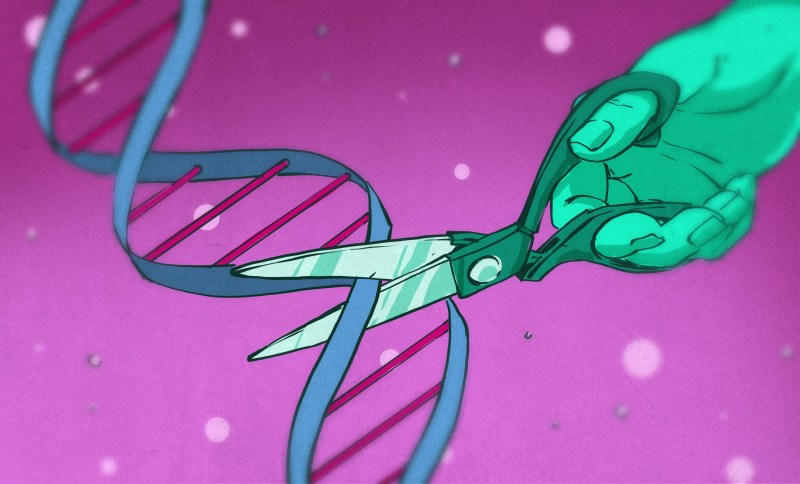It sounds like science fiction — and until 2012, the ability to cheaply and easily edit strings of DNA was exactly that. But as it turns out, CRISPR/Cas9 gene editing is a completely natural function in which bacteria catalogs its interactions with viruses by taking a snippet of the virus’ genetic material and filing it away for later.
Now, two women have won the 2020 Nobel Prize in Chemistry “for developing a method for genome editing”. Emmanuelle Charpentier and Jennifer Doudna leveraged CRISPR into a pair of genetic scissors and showed how sharp they are by proving that they can edit any string of DNA this way. Since Emmanuelle and Jennifer published their 2012 paper on CRISPR/Cas9, researchers have used these genetic scissors to create drought-resistant plants and look for new gene-based cancer therapies. Researchers are also hoping to use CRISPR/Cas9 to cure inherited diseases like Huntington’s and sickle cell anemia.
The discovery started with Emmanuelle Charpentier’s investigation of the Streptococcus pyogenes bacterium. She was trying to understand how its genes are regulated and was hoping to make an antibiotic. Once she teamed up with Jennifer Doudna, they found a scientific breakthrough instead.

Emmanuelle Charpentier Fights Flesh-Eating Bacteria
Emmanuelle Charpentier was born December 11th, 1968 in Juvisy-sur-Orge, France. She studied biochemistry, microbiology, and genetics at the Pierre and Marie Curie University, which is now known as Sorbonne University. Then she received a research doctorate from Institut Pasteur and worked as a university teaching assistant and research scientist. Dr. Charpentier is currently a director at the Max Planck Institute for Infection Biology in Berlin, and in 2018, she founded an independent research unit.
Upon completion of her doctorate, Dr. Charpentier spent a few years working in the States before winding up at the University of Vienna where she started a research group. Her focus was still on the bacteria Streptococcus pyogenes, which causes millions of people to suffer through infections like tonsillitis and impetigo each year. It also causes sepsis, which officially makes it a flesh-eating bacterium.
In 2009, Dr. Charpentier moved to northern Sweden to accept a research opportunity. She continued working on S. pyogenes and mapped the small RNAs found within. Along the way, Dr. Charpentier discovered a small RNA molecule whose genetic code is really close to the CRISPR sequence in its genome.
Although she had never worked with CRISPR before, Dr. Charpentier had her team map out the CRISPR system in the S. pyogenes bacterium. The system had already been shown to only need a single Cas protein to cut up virus DNA, but Dr. Charpentier discovered that the small RNA molecule, now named trans-activating crispr RNA or tracrRNA is necessary for the maturation of the long RNA created in the CRISPR process. At that point, Dr. Charpentier was excited about CRISPR and wanted to team up with a biochemist to advance the research. Her number one choice was Jennifer Doudna.

Jennifer Doudna Runs RNA Interference
Jennifer A. Doudna was born February 19th, 1964 in Washington, DC, but grew up in Hilo, Hawaii. She earned a BA from Pomona College in 1985, and a PhD from Harvard Medical School in 1989. Dr. Doudna is currently a professor of chemistry and of molecular and cell biology at UC Berkley as well as an adjunct professor of cellular and molecular pharmacology at UC San Francisco.
Toward the beginning of her career, Dr. Doudna studied RNA enzymes with the hope of uncovering their structure and biological function. Two decades later, her lab is still focused on RNA, where they are now working to understand the biological processes that involve RNA by a combination of using CRISPR, microRNAs, and RNA interference.
The last one, RNA interference, is the process by which RNA handles gene regulation. It’s also known as RNA silencing. In RNA interference, a gene’s protein production is turned off by a small interfering RNA — a tiny molecule of RNA that hunts down any messenger RNA that matches it exactly and snuffs them out.
In 2006, Dr. Doudna got a call from a microbiologist colleague telling her about a new discovery called CRISPR. The colleague said that no one knew much about it yet, but they suspected it worked a lot like RNA interference. Researchers had compared some vastly different bacteria and found that they all shared some repetitive DNA sequences. The repeated sequences themselves are known as CRISPR — clustered, regularly inter-spaced, short palindromic repeats. Within the sequences are shorter and unique, non-repetitive sequences that match the genes of various viruses. So the hypothesis is that the bacteria take a souvenir from every virus they survive, like collecting teeth on a necklace.
Dr. Doudna also learned that researchers have discovered special genes that they are calling CRISPR-associated, or Cas. She put her research team on the trail of Cas proteins, wondering if their purpose is to cut up strings of DNA.

Pairing Up to Hunt Down the Scissors
In the Spring of 2011, Dr. Charpentier was asked to speak at a conference in Puerto Rico to discuss her findings surrounding tracrRNA. She decided to use the opportunity to introduce herself to Dr. Doudna.
The two met by chance at a cafe on the second day of the conference, introduced by a colleague of Dr. Doudna. On a stroll through the old capital streets the following day, they decide to collaborate and study the function of Cas9 proteins in S. pyogenes. They suspect that the longer CRISPR-RNA is what identifies the virus DNA, and that the Cas9 protein does the actual cutting.
Over the next few months, the two teams perform many DNA-cleaving experiments, but nothing happened. Eventually they added tracrRNA to the pot, and voilà, the DNA molecule was cut in two.
Not content to stop there, they worked to simplify the scissors by combining tracrRNA and CRISPR-RNA into a single molecule, now known as guide RNA. They went on to precisely cleave a gene in five different places before presenting their 2012 paper on CRISPR/Cas9.
The Future of Gene Editing
CRISPR is an exciting field because there are a lot of different ways it can be used in both the animal and vegetable kingdoms. Dr. Doudna discusses some of those methods in this interview with Future Human shortly after her Nobel win. Her company Mammoth Biosciences is working on a rapid CRISPR-based test for COVID-19 and hoping to have one down the road that’s as simple as a home pregnancy test. She has another CRISPR company focused on neurodegenerative diseases like Alzheimer’s and Parkinson’s.
We are excited to see all the places that CRISPR/Cas9 gene editing takes us. Congratulations to Drs. Charpentier and Doudna!
















The sophistication of biology puts all our technology to shame. This is a solid step in the direction of ad hoc DNA modification. This prize is well deserved.
Well biology has had 3.5 billion years where as we’ve only been working on technology for about a couple hundred of thousand so its no wonder that biology has come up with a few good ideas.
I’m going to be that guy. Can you imagine studying molecular biology with a name like DouDNA?
Like being a doctor being named Billy Rubin.
You are that guy….I didn’t see that!
Of course they were first, “In 2012, a group led by Charpentier and Doudna1, and several months later one led by Siksnys2, reported programming the CRISPR–Cas9 system to cut DNA at specific sites”.
But yeah, Nobel phuckers kind of snubbed him there.
Interesting article and discussion. I have a book recommendation for anyone who wants to learn the basics of CRISPR gene editing. CRISPR: A Powerful Way to Change DNA includes an overview of genetics, an introduction to the applications of CRISPR and a discussion of the potential implications. http://www.yolandaridge.com/nonfiction/crispr
I’m surprised about this prize. The researcher that has create the crispr technology is áspanos guy named Francis Mojica. He found and study it in bacteria. The winners of the Nobel took this technology and made it suitable for humans. But the Nobel jury has left the true discoverer out of the prize…